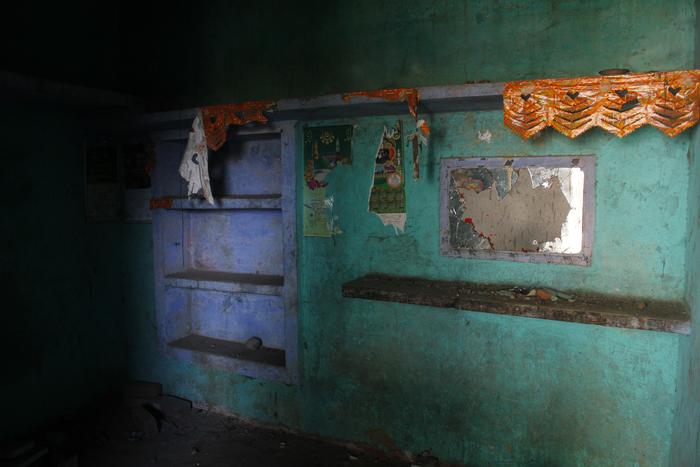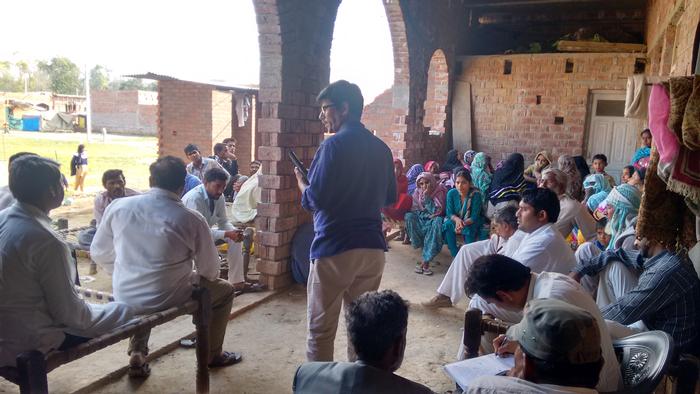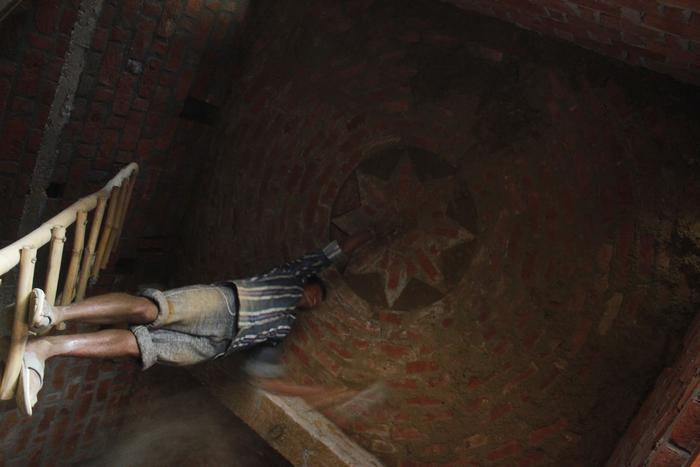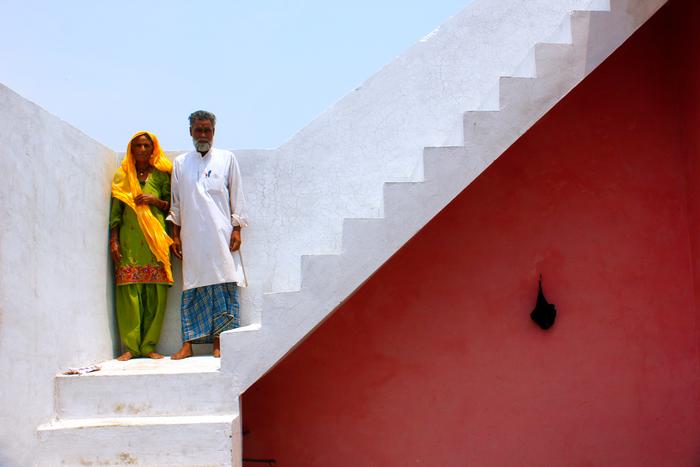[ID:2029] Building Identities and Trust - The Muzaffarnagar StoryIndia June, 2015 Kairana - The house-building process is almost complete. Raheesa overrules my proposal to paint her home white, in favor of the dark green color reminiscent of her previous home. The tenacity with which the displaced hold on to their memories makes me wonder; will their aspirations of a happy life in a new "pucca" house in a place away from their harsh past be realized?
Communal riots wrack Muzaffarnagar in September, leaving the people scarred and homeless. The conflicts had been brewing for weeks, impending parliamentary elections had already created an atmosphere where tensions ran high between factions. As clashes erupted and fireballed into riots, Roju recollects how they sent most of the women with young kids to safe places. The men stayed back together to defend and protect their homes. A staggering majority of the houses were burnt and vandalised. Paramilitary forces had to be called in to establish peace and for rescue operations. This single largest incident of violence in Uttar Pradesh since Indian Independence affected almost fifty thousand people across nine villages. Overnight, people were forced to flee the homes they had been inhabiting for generations.
As of mid-December, this impromptu relief camp was supporting 7,000 to 10,000 internally displaced families, with a similar number of people being supported by camps in other villages of Muzaffarnagar and Shamli districts. Kallu gives a stirring account of the year-and-half spent in one of the bleak shelter camps, speaking of loss of trust and identity that their thin tarpaulin tents couldn’t recover. Ten state-run relief camps were established, a temporary measure for immediate relief.
The shelter camps became witness to labors of Joint Citizen’s Initiative (JCI), an umbrella organisation of a collective of citizen-supported NGOs like Janvikas, Vanangana, Sambhavana and Sanathkada. The social organisations assisted the homeless in their arduous journey to justice and rehabilitation. The government vocabulary did not include “Internal Displacement”, thus, the people were devoid of their rightful status even as victims of displacement due to violence. Gagan Sethi of Janvikas recounts their efforts to amend legal definitions and inspire policy changes in order to affect a remedial response from the state. Eventually, the government acknowledged riot victims as Internally Displaced Persons and provided monetary compensation. By definition, Internally Displaced Persons (IDPs) have fled their homes but have not crossed an international frontier. As of the end of 2014, 38 million people around the world had been forced to flee their homes by armed conflict and violence, and were living in displacement within the borders of their own country. This represents a 15 per cent increase on 2013, and includes 11 million people who were newly displaced during the year, the equivalent of 30,000 people a day. [Source: IDMC (2015)]
After issuing a basic monetary compensation, the government ordered formal shut downs of relief camps in an effort to restore the illusion of public order. Makeshift settlements mushroomed, the scattered population pitching their relief tents near the original campsites. With a part of the compensation money, some families bought adjoining parcels of land to form new settlements- the dire loss of trust prevented them from returning to their home villages. One such newly populated settlement was Kairana.
February, 2014, Kairana - In almost every resettlement effort after a conflict, a systematic stepwise transition towards reconstruction is required. Conflict is integral to human life; maturity of a society is revealed by the way it handles conflict and its aftermath. Violence based on religious and communal grounds gives rise to apathetic and “politically correct” propagators of social peace, who avoid delving into the root causes of incidents by denying their relevance to rehabilitation. Also, the physical and psychological needs of people who have survived such trauma are nonstandard and diverse. The people who understand this situation the best, are the victims themselves, thus, it is imperative to involve them in the reconstruction process. There is, however, a strong play of power as a driving force that determines the acceptance of a participative design process. In most state-funded endeavors, there are expressions of authoritative superiority with overarching interests that control the design of the housing. Such a top-down model may not be agreeable to the end user group. Conversely, a grassroot design initiative giving power of design to the end user may be popular among the masses but not among the authorities.
Based in Bhuj, Gujarat, Hunnarshala is a not-for-profit architectural organisation, that holds a participatory approach paramount in all its projects. It is insistent upon social architecture and sustainable designs. When permanent settlements began to consolidate into villages, the families had neither had the means, nor the expertise to rebuild neighbourhoods with proper infrastructure like water supply, sanitation or community spaces. These families had demonstrated an effort to rebuild their lives, to work towards their rehabilitation as equal participants, not as disengaged beneficiaries. The architects and interns working for Hunnarshala provided them with the technical know-how and expertise to lay civic services and amenities.
These teams of architects, interns, volunteers, and families that have been working on ground are of diverse faiths, backgrounds and skills. It is vital to work across socio-cultural boundaries to break psychological barriers. In words of Hardika, the project coordinator, “It is an attempt, in brick and mortar, to stem ghettoization of minds and hearts. The purpose is to provide a replicable, financially feasible, humane and unifying rehabilitation model for post-violence displacement.” An owner-driven approach where people design and construct their own houses has a host of added intangible benefits - it helps restore pride and keeps the people gainfully employed. Also, owner-constructed houses tend to be more sustainable in the long term, as they involve the use of familiar local materials, and as the alterations and repairs can be carried out by the residents themselves.
In Kairana, each dwelling constructed is unique, in contrast to the prototypical box-like solutions that one comes across as rehabilitation housing. Hunnarshala, literally abode of skill, brings about a modern revival of vernacular building techniques of Muzaffarnagar - traditional indigenous methods are employed in a way that they have scope for innovation. It not only helps people to build stronger and earthquake resistant homes, but also propagates practices like building shallow domes, indigenous flooring patterns and local plastering styles. It encourages artisans like Nawab, a riot-affected mason, also a blacksmith by trade. He helps to construct houses of other beneficiaries; his skills of making shallow brick domes, brick roofs and paper cutting patterns in flooring have earned him repute as an artisan. Nawab’s vernacular method of making brick domes, which he learnt from his Guru, was new to Hunnarshala. Expert advice was sought and modifications done to make the dome earthquake resistant. Nawab is now being encouraged to form his own team of brick masons and artists, and take up independent projects. When Nawab was informed about CSEB, he expressed his desire to learn the process and make his own house out of earth blocks in order to analyse it over time and use it for other houses. Being a blacksmith, he wanted to make his own machine to compress earth blocks.
At Hunnarshala, facilitators of construction adhere to the local religious customs and sentiments while designing. They are mindful of small details that generally escape the notice of those designing mass-produced shelters, like keeping the toilet pan in a direction perpendicular to the Mecca facing away from it. There is a marked reuse of old material - whatever bricks, wooden beams, door and window frames that could be salvaged from their previous homes are incorporated while designing their new homes, thus saving cost and adding a distinct flavour of comfortable homeliness. In keeping with the vision to build back better, women are encouraged to use non-smoke LPG stoves instead of traditional wood-burning stoves called “choolhas”.
Puneet from Vanangana elucidates on how after the riot, women found themselves at the bottom rung of all three hierarchies - caste, class and gender - and were victims of rape, violence and eviction. Striving for a higher social status for women, it is mandatory for women to be included in the community meetings. The women play an important role in decision-making related to design and construction details. Sandeep Virmani, the director of Hunnarshala, notes that in general, it is the lady of the house who is more concerned about the organisation of spaces and their functionality. The women care more about the interior spaces of the house and details. They are multi-taskers themselves, conscious about the budget and good at construction management. Financial aid is transferred to the bank account registered in the name of the lady of the house, and last Rs. 10,000 of the aid is given directly to her to decorate the house and buy household equipment or utensils.
April, 2015 Kairana - My internship with Hunnarshala has given me the opportunity to live with riot victims for almost three months. I have realized that the people need architectural help, as well as social and emotional understanding.
My roommate Narayanji has been employed with Hunnarshala ever since its managing directors discovered his skills in bamboo and brick construction while working in flood-affected areas of Kosi river in the state of Bihar. After we come back from construction sites each evening, we talk about a variety of topics, from local building traditions, our diverse upbringings, to religion and cultural backgrounds. A natural singer, he would inadvertently start humming and drumming his fingers on the tabletop to any tune. On one such evening, we spontaneously decided to make a song about the process of construction, benefits of using rat-trap bonds, and the monetary compensation system. I supplied the lyrics, to which he added the rhythm of a famous local song, adapting the song into the local dialect. A mesmerizing performance soon followed where we were joined by other members; the song accompanied by claps, taps and cheers. Narayanji has a penchant for singing similar songs written on spur-of-the-moment at every construction site he goes, in order to raise awareness among the simple folk about modified vernacular building techniques.
I get involved in the daily lives of families, an architect and designer partaking in their joys and sorrows over tea. It is due to this bonding, I think, that we produce designs that satisfy not only physical functional needs but also emotional ones. Shaukat has three children; he wishes to divide the house such that each child would have his own contiguous part. I sit with him, and together we deliberate on how to accommodate this into the house plan. We divide the plot in way that each part has a separate entrance, distinct rooms, and toilets, and decide to leave a quarter of the plot unbuilt for future use. The thought for a settled future is palpable in the practice of getting designs for the entire house, but executing it incrementally according to requirement and affordability. Monetary remuneration in the project is also disbursed in installments pertaining to incremental construction. The fragmented method of funding, which allows people to obtain the capital only when that particular item of construction work is finished, ensures that a stepwise building procedure is followed discourages corruption or defection.
Across the period of my stay in Kairana, I have seen the new housing boost confidence and self-esteem of the young children who finally feel at ease, and at home, after more than a year of trauma and uncertainty. Their faces shine with the assurance that they have a secure place to stay and can resume their studies. Hunnarshala is also making dedicated efforts to improve access to elementary schools, they have proposed an informal education center until the displaced children are admitted into local schools, and they plan on using creative tools such as theater to encourage children’s articulation of resettlement experiences.
June, 2015, Kairana - The project at Muzaffarnagar is notable, yet there is scope for improvement. Several gaps need to be plugged in, and require expertise and fresh thoughts.All attention is given to individual houses, I recognise an absence of designed shared spaces. Site planning is absent, primarily due to the fact that plots were bought before the involvement of Hunnarshala. Even then, lack of funds and loss of momentum have put the proposed common spaces on hold. Such spaces, over time act as infrastructure of knowledge, and become places of informal congregation. They facilitate communication, cohesion and teamwork. Men can only come together to debate and deliberate, women can only come together to collaborate and share, children can only come together to play and learn, when they have a safe, dedicated, accessible and acceptable space for it.
My vision of a resilient community also includes thriving multi-use streets, thoroughfares that become transit and business corridors in the day and recreational spaces in the evening. At Kairana, means to establish links to the city could have been designed to ease mobility. I would have liked to incorporate my knowledge of spaces to design porches and verandahs for each house, so that people could spend as much time outdoors as indoors, improving the social quality of life.
It is typical of Hunnarshala to inspire a team of people skilled in a particular art to form a group, provide them with formal training from an expert, and register the group as an independent company - the woodworking artisans from Rajasthan founded a company called “Grains” after working with Hunnarshala for a project. This led me to ask if the resources of JCI could be pooled together to involve women in small enterprising cottage industries. Home-based activities could be planned that enable women, elderly and children to collaborate among themselves and generate a small income for the otherwise unemployed. Such small grassroot innovations create an enlightened society, and the ripple effects of touching one life are echoed in other lives, triggering a positive, productive chain reaction.
Conclusion: At Muzaffarnagar, a novel procedure was administered that provides the homeless with a hopeful agenda of rebuilding their lives. A three-way partnership was construed among the government, people and civil society that exemplified participation, mobility and empowerment starting from grassroot level. It is very conceivable to see this project being used as an advocacy tool to push for policy change in the near future.
This essay is an attempt to understand homelessness arising due to external situations and conditions beyond the control of an individual. We chose this particular example to recognise an unconventional manifestation of homelessness and its solution. Here is a demonstrative framework for the process of resettlement that smoothens the transition of the victims. A sense of inequality or violence would always be embedded in a housing solution if the external “provider” is not attached to the housing. As architects, and individuals, we must aim to come up with holistic, sensitive and human-scale solutions to homelessness, that improve quality of life in all respects, and not just provide shelter. And in my opinion, this dream can only be realised when all distinction between the benefactor and the beneficiary is eradicated.
If you would like to contact this author, please send a request to info@berkeleyprize.org. |




